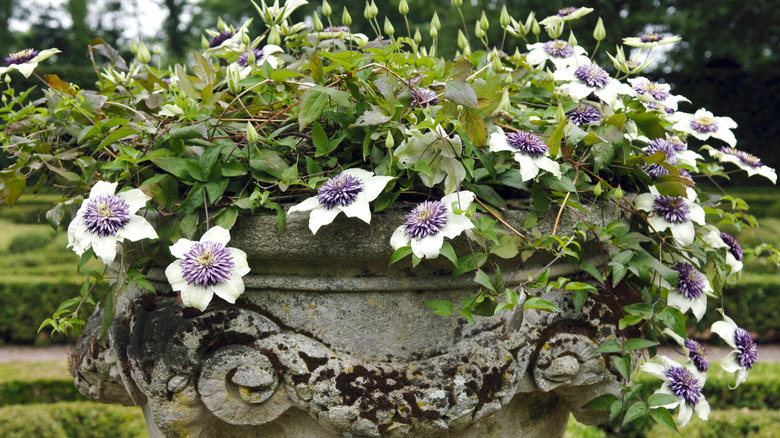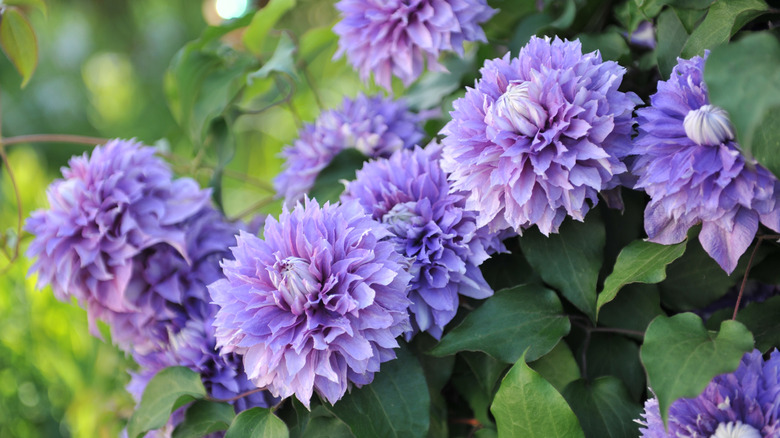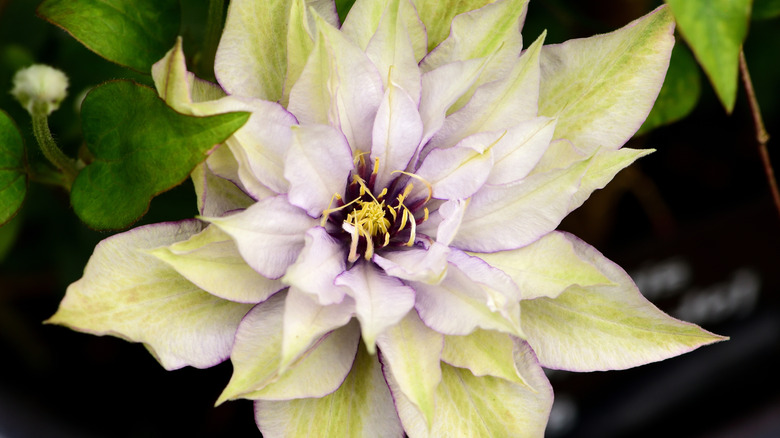The Best Clematis Varieties For Gorgeous Container Gardens
There is a clematis for everyone! Boasting a diversity of color, a wide array of flower shapes, and varieties that can cope with almost any growing conditions, clematis can be added to virtually any garden. Even if the only room you have in your garden is in a container, you will have clematis options to choose from, but some are more striking than others.
Because clematis also come in compact and slow-growing varieties, there will be many good options for your containers. There is, however, one thing to keep in mind. Clematis grown in containers are less winter hardy, though, that doesn't mean they can't make it through a winter. Clematis are generally hardy in Zone 4 to 11, but what you have to keep in mind when choosing your variety is that growing a clematis in a container will reduce its winter hardiness by one zone.
There is a lot you should know before planting clematis, but there are a few extra things to know if you're growing it in containers. For instance, choose a terracotta, ceramic, or any pot with a thick wall. Avoid plastic. A thicker walled container will help protect the plants in winter. Drainage is also important, so pick one with a good drainage hole and keep it raised up off the ground. From there, all you have to do is pick the variety that strikes your fancy and can adapt to your growing conditions.
Sun-loving clematis for containers
If you have a sunny spot ready for a beautiful climber like clematis to add drama and color, there are many options, but a few stand out. Clematis Carnaby has pink petals trimmed with white, and can quickly grow up to 8 feet long. Like most clematis, they prefer to have the flowers in the sun and their roots shaded, so they can be combined with other lower growing plants that can produce shade at the foot of the plants. Deadheading after the first bloom will encourage new flowers.
Clematis Diamantina shares a lot in common with Carnaby, but could not look more different with purple, double flowers of about 6 inches across. While they also bloom early on previous growth, they may flower again in late summer. If you want a large-flowered late-bloomer, opt for clematis Comtesse de Bouchaud, which has lovely pink flowers and contrasting yellow stamen. These will bloom throughout the summer, and can grow up to 10 feet long. Clematis Multi Blue are also eye-catching with multilayered, large flowers that come in two waves.
Before you plant any clematis, get to know more about invasive varieties of clematis and be sure to avoid those that could become a problem in your area. It's also worth noting clematis is toxic to pets, so if you have a dog or cat — or even a horse — who likes to munch on your garden plants, think twice before planting any clematis.
Shade-tolerant clematis for containers
If you have a shadier area in which to grow your clematis, looking for shade tolerant varieties that also thrive in containers will be critical for success. Clematis Alaina falls into the shade-tolerant category and can be a great option for balcony gardens, or anyone who doesn't have full-sun. Growing up to 5 feet long, Alaina is a shorter, bushier variety of clematis but still produces pink flowers freely from June through July. Clematis Samaritan Jo can also handle shade but does not climb. Its beautiful purple tinged petals with green ribs will bring the drama, though.
Clematis Crystal Fountain is another shade tolerant variety that boasts purple, semi-double flowers including silvery tufts of petaloids. Growers can expect two waves of flowering from this variety, starting with a first flowering in late-spring or early-summer and again in late-summer and early-fall. The petaloids often remain after the true petals fall away, providing additional interest.
Whichever variety is ultimately right for you, you will want a container that is at least 18 inches wide, with grit or stones added for good drainage and ensure you water regularly. Learning how and when to prune clematis will require paying attention to your particular variety's needs. This will change based on when your plants flower. And give them a better chance of making it through the winter by protecting roots in the winter using something like bubble wrap. In the spring, replace the top few inches of soil with compost to refresh the potting material.


